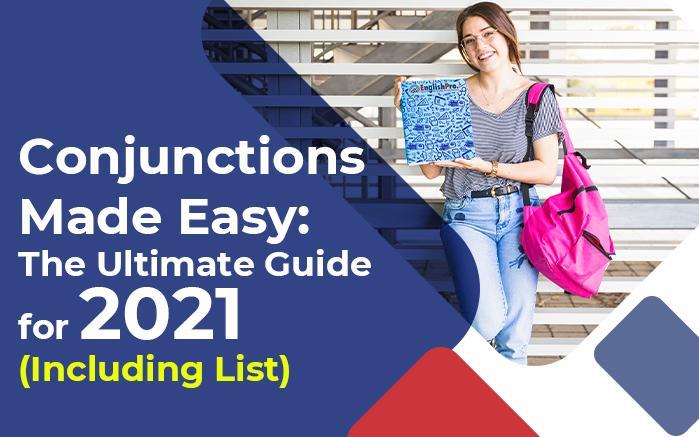When learning English grammar, hordes of people stumble upon the conjunction and wonder what it is and what the purpose is. This guide will be highly beneficial for those who want to learn the use of conjunctions and make their grammar impeccable.
So, what is a Conjunction?
A conjunction is considered among the nine parts of a speech. The need for conjunction arises to link thoughts and ideas within a sentence. It lets people make clear and elegant sentences by eliminating the complexity of short sentences.
For better understanding, you can consider conjunctions as ‘the glue’ of a phrase. Without the use of conjunctions, sharing ideas and thoughts with a flow is not possible.
Let’s understand it better with an example.
“That guy has a radiant smile and afit body. He has a majestic beard with brown eyes, and he is wearing a black coat on top of a check blue shirt. Definitely, he has some great sense of styling.”
After seeing words highlighted in bold, it is crystal clear how conjunctions bring thoughts together and make a flowing sentence. Now, let’s see how the wording would be without the use of conjunctions.
“That guy has a radiant smile. That guy has a fit body. He has a majestic beard. He has brown eyes. He is wearing a black coat. He is wearing a check blue shirt.”
Due to too many words and sentences, it does not sound audibly appealing. Consistency is imperative when using conjunctions.
Types of Conjunctions
Conjunctions may not seem astonishing, but they essential for making appealing sentences. They help people bring their complex thoughts together. These are used in everyday life in written and verbal communications.
Coordinating Conjunctions
Coordinating conjunctions join two parts of a sentence. These can go between phrases, words, and clauses. With the use of the acronym FANBOYS, you can learn coordinating conjunctions easily.
- F is for “FOR”
- A is for “AND”
- N is for “NOR”
- B is for “BUT”
- O is for “OR”
- Y is for “YET “
- S is for “SO”
It is whimsically essential to know that they serve various purposes when used. For example, “So” highlights a phrase, word, or clause.
Correlative Conjunctions
With the help of correlative conjunctions, you can make a correlation between two phrases and words. These conjunctions work in pairs and are placed at different points within a sentence. In order to make correlative conjunctions function adequately, it is necessary to add both terms in the sentence.
There are many pairs of correlative conjunctions. You can use the below-mentioned correlative pairs to structure your sentence.
- No sooner/than
- Rather/than
- So/that
- Such/that
- Both/and
- Not only/but also
- Neither/nor
- Whether/ or
- If/then
- As/as
- The/the
- Just/so
- Either/or
Some of the examples of correlative conjunctions are:
- No sooner did he begin to work than the phone ring.
- I didn’t know whether you’d like a latte or cappuccino.
- He not only trains hard but also grooms well.
- I’ll either eat Ice-cream or carrot pudding after supper.
Subordinating Conjunctions
Subordinating conjunctions link subordinate clauses to main clauses. Using only a subordinate clause leads to the fragment error. However, the main clause can operate as a complete sentence. So, a subordinate clause is added for some additional information to a sentence.
You may see these conjunctions at the beginning of a sentence when a subordinate clause appears before the main clause. In a subordinate clause, you can find “because” at the beginning of a sentence.
Many times, teachers tell their students not to begin a sentence with ‘Because.’ They do it to prevent students from writing sentences with fragment errors. However, some students start believing that a sentence starting with because is wrong. The matter of fact is that ‘Because’ is a subordinate conjunction, so it can be used at the beginning of a sentence.
Here are some of the most-used subordinating conjunctions:
- As
- Although
- As If
- As Much As
- As Soon As
- Whenever
- Supposing
- When
- Where
- Wherever
- Whereas
- Where If
- Whether
- Though
- Now That
- Now Since
- Now When
- Now
- Even If
- In Case
- Lest
- Even
- Even Though
- Provided
- Provide That
- If
- If then
- By The Time
- In As Much As
- Inasmuch
- In order to
- In order that
- If When
- Since
- Because
- Whose
- Whoever
- Unless
- While
- Before
- Why
- So That
- Until
- As Though
- If Only
- Just As
- How
- Since
- Than
- Till
- As
- As If
- As Long As
- As Much As
- As Soon As
- As Far As
- After
- Although
- Or Not
- What
Conclusion
Learning English grammar is a vital first step in developing fluency in English. We’ve tried to make this Conjunctions guide as concise and easy to understand as possible. If you are serious about making your English impeccable, we recommend joining a reputed institute for English speaking course in Chandigarh. Getting excited yet? You should be! The journey of English learning is fascinating and brings lots of fun. Stay tuned for our next blog.


Recent Comments